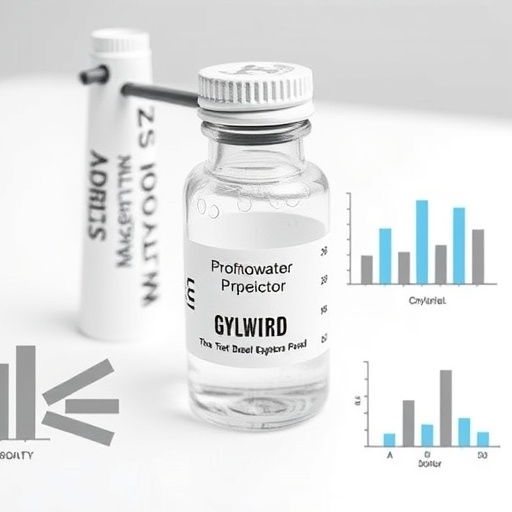In a significant advancement in the field of environmental monitoring, researchers have developed a robust method for detecting anabolic-androgenic steroids (AAS) in wastewater. This breakthrough study, led by a team of experts including B.S. Ertas, H. Sener, and İ.E. Gören, focuses on the identification of two specific steroids: methenolone and 19-norandrosterone. Given the increasing awareness of environmental contaminants and their potential effects on human health and ecosystems, this research holds importance in mitigating the risks associated with such substances.
Anabolic-androgenic steroids, commonly associated with performance enhancement and bodybuilding, have been detected in various environments. Their presence in wastewater poses significant concerns due to their bioactive nature, potentially affecting aquatic life and even entering the human food chain through contaminated water sources. As such, finding effective methods to monitor these substances in wastewater is crucial for public health and environmental safety.
This study meticulously validated a method that not only detects these steroids but also quantifies their concentration in wastewater samples. The validation process involved rigorous testing protocols to ensure reliability, sensitivity, and specificity of the method. The researchers employed advanced analytical techniques, enhancing the accuracy and reducing the chances of false positives and negatives in the detection of methenolone and 19-norandrosterone.
The method validation included a comprehensive examination of various parameters, such as limits of detection, calibration curves, and recovery rates. Each parameter was systematically evaluated, ensuring that the method could be reliably used in diverse settings. The research team demonstrated that the technique could effectively detect steroid levels down to minute concentrations, an essential feature for monitoring pollutants in complex matrices like wastewater.
Applying this validated method to real wastewater samples revealed alarming findings regarding the presence of these anabolic steroids. The researchers collected samples from various wastewater treatment facilities and were able to determine the concentration levels of methenolone and 19-norandrosterone across different sites. This practical application underscores the importance of the study as it not only provides a theoretical framework but also delivers concrete evidences of environmental contamination by AAS.
The findings from the wastewater samples highlight a pressing issue within urban environments where illicit steroid use is rampant. In many cases, individuals utilizing AAS for performance enhancement or aesthetic purposes do not consider the broader implications of their actions on the environment. By showcasing the presence of these steroids in wastewater, the researchers call attention to the need for increased public awareness and potential regulatory measures to address this contamination.
One striking aspect of the research is the implications it has for future monitoring and regulatory frameworks. As more studies continue to reveal the prevalence of various contaminants in wastewater, this work paves the way for comprehensive environmental policies aimed at mitigating the impacts of pharmaceutical and endocrine-disrupting substances. The research serves as a foundation for developing further analytical methods to explore additional pollutants that could be harmful to ecosystems.
The study also opens avenues for interdisciplinary collaboration among environmental scientists, toxicologists, and policymakers. By integrating findings from various fields, stakeholders can create more effective strategies for managing the risks associated with anabolic steroids in the environment. Increased collaboration is essential as it can lead to more comprehensive solutions that address both human and environmental health.
Furthermore, this research invites public discussion regarding the ethical implications of steroid use, particularly in competitive sports and bodybuilding. The persistence of anabolic steroids in the environment is symptomatic of broader societal issues regarding substance misuse and its opportunities for regulation. Open dialogue surrounding responsible usage and consequences can enhance community engagement and foster a culture of accountability.
Highlighting the role of wastewater treatment facilities is vital, as these systems serve as the frontline in battling environmental contamination. Upgrading treatment technologies could play a pivotal role in reducing the levels of such contaminants before they enter natural water bodies. As scientists continue to explore effective remediation techniques, this validated method may offer guidance for future developments in treatment processes.
Given the increasing urgency surrounding environmental issues and the quest for sustainable practices, this research contributes significantly to the growing body of literature on wastewater monitoring. By presenting a reliable method for detecting AAS, the study adds value to both environmental science and public health fields. It emphasizes the importance of monitoring emerging contaminants while driving initiatives that pave the way for cleaner, safer water ecosystems.
The results are not simply a technical achievement; they reflect a critical understanding of the interconnectedness between human activity, environmental health, and regulatory practices. The study’s comprehensive approach provides a model that can be replicated in various contexts, ensuring that society addresses the challenges posed by pollution in a well-rounded manner.
Overall, the method validated by Ertas and his colleagues marks a notable step toward effective environmental monitoring of pharmaceutical contaminants. This research reinforces the critical need for ongoing vigilance in assessing the impacts of human behavior on the environment, particularly concerning substances that are often overlooked. It is a call to action for continued research and responsibility toward sustainable practices.
Subject of Research: Detection of anabolic-androgenic steroids in wastewater.
Article Title: Method validation for the detection of the anabolic–androgenic steroids methenolone and 19-norandrosterone in wastewater and application to real wastewater samples.
Article References: Ertas, B.S., Sener, H., Gören, İ.E. et al. Method validation for the detection of the anabolic–androgenic steroids methenolone and 19-norandrosterone in wastewater and application to real wastewater samples. Environ Monit Assess 197, 1333 (2025). https://doi.org/10.1007/s10661-025-14799-5
Image Credits: AI Generated
DOI: https://doi.org/10.1007/s10661-025-14799-5
Keywords: Wastewater, Anabolic-Androgenic Steroids, Environmental Monitoring, Methenolone, 19-Norandrosterone.




